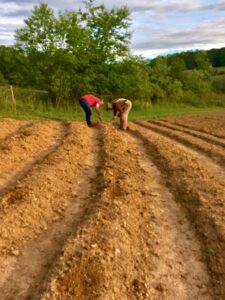Don’t Plant Your Veggies Too Early!!!
go.ncsu.edu/readext?773377
en Español / em Português
El inglés es el idioma de control de esta página. En la medida en que haya algún conflicto entre la traducción al inglés y la traducción, el inglés prevalece.
Al hacer clic en el enlace de traducción se activa un servicio de traducción gratuito para convertir la página al español. Al igual que con cualquier traducción por Internet, la conversión no es sensible al contexto y puede que no traduzca el texto en su significado original. NC State Extension no garantiza la exactitud del texto traducido. Por favor, tenga en cuenta que algunas aplicaciones y/o servicios pueden no funcionar como se espera cuando se traducen.
Português
Inglês é o idioma de controle desta página. Na medida que haja algum conflito entre o texto original em Inglês e a tradução, o Inglês prevalece.
Ao clicar no link de tradução, um serviço gratuito de tradução será ativado para converter a página para o Português. Como em qualquer tradução pela internet, a conversão não é sensivel ao contexto e pode não ocorrer a tradução para o significado orginal. O serviço de Extensão da Carolina do Norte (NC State Extension) não garante a exatidão do texto traduzido. Por favor, observe que algumas funções ou serviços podem não funcionar como esperado após a tradução.
English
English is the controlling language of this page. To the extent there is any conflict between the English text and the translation, English controls.
Clicking on the translation link activates a free translation service to convert the page to Spanish. As with any Internet translation, the conversion is not context-sensitive and may not translate the text to its original meaning. NC State Extension does not guarantee the accuracy of the translated text. Please note that some applications and/or services may not function as expected when translated.
Collapse ▲Three days of temperatures in the mid-fifties makes every gardener worth his or her salt want to get out and start planting their vegetable garden. With the daffodils pushing up leaves and the buds on the trees swelling, spring looks like it is on its way. But beware, the ‘garden-gods,’ like the Greek gods of old, love to play tricks and torment their innocent subjects.
Take it from one who has been made a fool by the ‘gardening deities’. The average final frost date is April 20. Lately however, we seem to get a frost closer to Mother’s Day. Even though I can still hear my grandma telling me to wait to plant my garden until the leaves on the oak trees are the size of a squirrel’s ear, more than one spring has found me planting tomatoes and peppers in April, only to be out in the cold like a fool in the dark covering up the cold sensitive plants with anything I could find. The next morning I would be out there before work removing the sheets, blankets, buckets and flower pots that I had used to guard my tender plants. I am sure my grandma would have chuckled at the sight.
The soil temperature in the spring can be in the 30s-50s F locally depending which side of the mountain you are on according to NC State Climate team website. Most of our garden plants need soil temperatures around 65 degrees to germinate and grow successfully. If you plant your warm season seeds and transplants too early, they will not grow due to the cool soil. A tomato planted in the cool soil will just sit there until the soil warms up, so what is the point of planting early and having to worry about late frosts?
Another reason to wait to plant your summer vegetable garden is that Henderson County soils are still saturated from the snows of earlier this year. Running your tiller through your garden will only form big sticky clay clumps. The soil needs to be relatively dry when you plow.
Don’t fret though. We can still plant some spring veggies. Leafy greens, turnips, radishes and mustard can all be planted indoors in February and outdoors in mid-March according to NC State’s gardening calendar. It is also a great time to soil test your garden and apply lime as needed.
Waiting to plant your summer garden until Mother’s Day will save you time, money and frustration. You will also avoid becoming a victim of the ‘gardening-gods’ favorite practical joke; the late spring frost.





